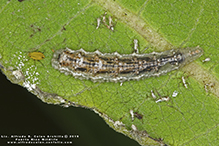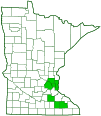American hover fly
(Eupeodes americanus)
Conservation • Description • Habitat • Ecology • Distribution • Taxonomy
|
|
||||||||||||||
Description |
American hover fly is a small, wasp-mimic, aphideater. In the United States, it occurs east of the Great Plains and there are a few scattered records in California and Arizona. It also occurs across southern Canada. The larvae feed on aphids. Adults are found from mid-April to mid-November in meadows, weedy fields, forests, plantations, and gardens. They feed on flower nectar. Adults are ¼″ to 7 ⁄16″ (7 to 11 mm) long. Females of this species cannot be distinguished from Eupeodes pomus. Males can be distinguished only by their clasping organs (surstyli). The head is wider than the thorax. There are two large compound eyes on the sides of the head and three small simple eyes (ocelli) in a triangle on top of the head. The compound eyes are bare, with no erect hairs. On the male they meet at the top of the head. On the female they do not. The face is mostly yellow but has a brown to black stripe in the middle and a small brown spot above each antenna. The cheek is yellow toward the front, blackish toward the rear. The protruding mouthpart (proboscis) is short and fleshy. The antennae are short and have just three segments. On the third segment there is a stiff, forward-pointing bristle (arista). The thorax is large, shiny, and black. It is covered with short, erect, yellow hairs, densely on the sides, sparsely above. The exoskeletal plate between the abdomen and thorax (scutellum) is large, rounded, dull yellow, and translucent. It is covered with pale yellow hairs above and has a moderately dense fringe on the rear margin. The abdomen is longer and broader than the thorax, oval when viewed from above, and nearly flat when viewed from the side. It is black with bright yellow markings. There are five visible segments. On the male, segment 1 is very narrow and entirely black. Segment 2 has a pair of large spots that almost reach the lateral margins. On most individuals the spots are distinctly separated in the middle. On some individuals, they meet in the middle. Segments 3 and 4 each have a broad yellow band that does not quite reach the lateral margins. The forward margin of the band is nearly straight, the rear margin is nearly straight or shallowly concave in the middle. Segment 4 has a broad stripe on the rear margin. Segment 5 is yellow with a narrow black band. On the male the surstyli are long and twisted. The legs are mostly yellow and brownish-yellow. The first segment of each leg (coxa) is black. The base of the third segment (femur) of the front and middle legs is black. The femurs on the hind leg is slender, not thickened. The wings are clear and are mostly covered with short erect hairs. The lobe attached to the base of the wing (alula) is broad and is itself wing-like. The inner third of the alula is bare, with no hairs. There is a spurious vein between the radius (R) and media (M) veins. The anal cell is long and is closed near the wing margin. The marginal, R5, and M2 cells are also closed. The R4+5 vein is nearly straight. |
Size |
Total length: ¼″ to 7 ⁄16″ (7 to 11 mm) |
Similar Species |
Short-tailed aphideater (Eupeodes pomus) adult male surstyli are short, but they are otherwise identical. Females are indistinguishable. |
Habitat |
Meadows, weedy fields, forests, plantations, and gardens |
Ecology |
Season |
Two generations per year: Mid-April to mid-November |
Behavior |
|
Life Cycle |
|
Larva Food |
Aphids |
Adult Food |
Flower nectar |
Distribution |
||
|
Sources |
|
| 4/17/2024 | ||
Occurrence |
||
Widespread and very common |
||
Taxonomy |
|
Order |
|
Suborder |
Brachycera |
Infraorder |
Cyclorrhapha |
Zoosection |
Aschiza |
Family |
Syrphidae (Hover Flies) |
Subfamily |
|
Tribe |
Syrphini |
Genus |
Eupeodes (Aphideaters) |
Subgenus |
|
no rank |
Eupeodes americanus complex (long-tailed aphideater complex) |
Synonyms |
|
Metasyrphus wiedemanni Syrphus americanus Syrphus canadensis Syrphus lebanoensis Syrphus medius Syrphus wiedemanni |
|
Common Names |
|
American hover fly American hoverfly long-tailed aphideater |
|
This species is widely known by the common name “American hover fly.” NatureServe and iNaturalist use the common name “long-tailed aphideater,“ which acknowledges the close similarity to Eupeodes pomus, which is called “short-tailed aphideater.” The “tail” in the name refers to the claspers near the end of the male abdomen. |
|
Glossary
Alula
A broad lobe at the base of the wing of some flies and beetles.
Arista
A large bristle on the upper side of the third segment of the antenna of a fly. Plural: aristae.
Femur
On insects and arachnids, the third, largest, most robust segment of the leg, coming immediately before the tibia. On humans, the thigh bone.
Ocellus
Simple eye; an eye with a single lens. Plural: ocelli.
Proboscis
The tube-like protruding mouthpart(s) of a sucking insect.
Scutellum
The exoskeletal plate covering the rearward (posterior) part of the middle segment of the thorax in some insects. In Coleoptera, Hemiptera, and Homoptera, the dorsal, often triangular plate behind the pronotum and between the bases of the front wings. In Diptera, the exoskeletal plate between the abdomen and the thorax.
Spurious vein
A longitudinal, thickened line between the radius and media veins. It resembles a true vein but is not connected to any other veins.
Visitor Photos |
||
Share your photo of this insect. |
||
This button not working for you? |
||
Alfredo Colon |
||
 |
||
MinnesotaSeasons.com Photos |
||
|
||
|
||

Slideshows |
|

Visitor Videos |
||
Share your video of this insect. |
||
This button not working for you? |
||
|
Other Videos |
||
American hoverfly (Eupeodes americanus) Working |
About
Published on Mar 4, 2017 American Hoverfly (Eupeodes americanus) |
AMERICAN HOvER-FLY IN SLOW MOTION |
About
Published on Aug 14, 2015 AMERICAN HOvER-FLY IN SLOW MOTION |
Metasyrphus americanus (drone fly, American hover fly) foraging, 8/24/13, MD |
About
Published on Sep 8, 2013 Metasyrphus americanus (drone fly, American hover fly) foraging, 8/24/13, MD |

Created: 2/21/2019 Last Updated: © MinnesotaSeasons.com. All rights reserved. |


